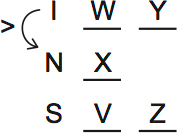On question 15, I talked about using a hard/easy test to judge which answers to try first on CANNOT be true questions.
“Hard” is an answer that doesn’t work with a rule and makes it harder to obey a rule. “Easy” is an answer that conforms with a rule.
For instance, putting V in Iceland is “hard”. That’s because it restricts the game by forcing Z into Sweden. So not putting V with Iceland is “easy” because it removes a potential restriction.
Therefore A is easy. We should skip it and try other answers.
B and C are a mix. B does remove the fourth rule (because V isn’t in Iceland). And C does place WY together.
But on the other hand, both answers force X to be in Norway, because X isn’t in Sweden (rule 2), and they both take up two artifacts, so that makes it harder to put more artifacts in Iceland than Norway. We should try both answers.
D is easy. It complies with rule 2 (X in Norway or Sweden) and with rule 4 (Z is in Sweden, so now it doesn’t matter where V goes).
E seems hard because it has four artifacts in Sweden, but there’s nothing wrong with it. We can just put Z in Iceland:

This obeys all the rules. So let’s try B and C.
This diagram shows B is possible:

C is CORRECT. If only WY are in Sweden, X must go in Norway:

Now, we need to place more artifacts in Iceland than in Norway (rule 3). Only V and Z are left. But they can’t both go in Iceland, because of rule 4. If V is in Iceland, Z goes to Sweden. So C is impossible.
Note: it took a lot of writing to judge whether all five answers were “easy” or “hard”. But that’s because it takes a lot of words to explain things out loud. If you know the rules, you can see these answers as hard/easy almost instantly.
It’s that process I’d like you to try to practice. Ask if answers answers conform with a rule, or make it harder to obey a rule?.


in this answer it seems that you say the answer C=CORRECT and also C=impossible, and it seems that you say E though seemingly difficult is the answer. Which answer is correct?
LSAT 72, Logic Game 3, Question 18
It’s a can’t be true question. So “impossible” is what we’re looking for. E, though seemingly difficult, is actually possible, and therefore wrong.
Maybe I should add question types to this LG section, actually….